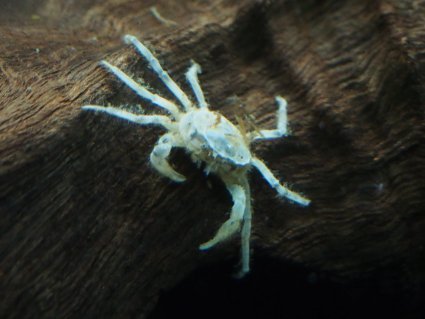
Thai Micro Crab

Care
The Thai Micro Spider Crab is an unusual miniature species, currently known from just one river in Thailand where they live amongst the roots of floating Water Hyacinths. These tiny decapods are entirely aquatic, and live exclusively in freshwater. They are not a true spider crab as the common name might imply, but actually a member of the Hymenosomatidae family of false spider crabs. This family is comprised of 19 genera including Limnopilos, which itself contains 3 species, one of which is L. naiyanetri. These crabs adapt well to aquarium life if they are given the mature, stable conditions that are required (conditions that are, in fact, very similar to those preferred by Red Crystal Shrimps). The tank should be furnished with plenty of rockwork and driftwood, along with dense planting which includes floating species. Many aquarists have found that these shy little crabs relish resting in the nooks and crannies of the driftwood, just as much as they do amongst the plants. Bright lighting should encourage a bit of natural algae growth, which these omnivores will enjoy browsing upon, likely for the microorganisms it contains. Keep in colonies of 5 or more, as this is a non-territorial, gregarious species. Tankmates should be small and peaceful e.g. micro-Rasboras, small tetras, kuhli loaches, Caridina and Neocaridina shrimps, fan shrimps etc. These crabs can be quite variable in colouration, but most are a very light grey with darker brown blotches on the carapace, legs, and chelipeds (claws). The legs are very long in relation to the size of the distinctive, round carapace, and can be neatly folded under to appear half their actual length. The legs and chelipeds are covered with short, strong setae (bristles) which are used to capture food particles. Although Thai Micro Spider Crabs are generally non-aggressive, and many aquarists keep them perfectly safely alongside adult shrimps and snails, be aware that they may predate on tiny baby shrimplets and very young ornamental snails. They are totally safe with plants. Like other crabs, this species will occasionally moult as it grows, and during this period is vulnerable to attack and will tend to hide away until the new exoskeleton hardens.
Feeding
Omnivorous. Can be finicky. Offer a variety of small meaty frozen foods and a wide range of quality sinking dried foods (meaty and Spirulina based), along with an ongoing supply of natural algae.
Breeding
Many aquarists have seen their females carrying eggs, but there seems to be considerable difficulty with raising the zoea (larvae). This species would make an excellent breeding project for the serious hobbyist. At the beginning of the gestation period, the large eggs (~0.6mm in diameter) carried on the female’s pleon, are orange in colour, and these gradually turn yellow and then eventually grey. At the end of the gestation period, the female releases the zoea, and in the wild these are believed to develop entirely in freshwater. It is important to use over-tank illumination during breeding attempts, as the zoea are dependent on light to orientate themselves correctly in the water column. Currently no aquarists have managed to successfully raise the zoea past 9 days, and a definitive reason has not yet been identified.
The Thai Micro Spider Crab is an unusual miniature species, currently known from just one river in Thailand where they live amongst the roots of floating Water Hyacinths. These tiny decapods are entirely aquatic, and live exclusively in freshwater. They are not a true spider crab as the common name might imply, but actually a member of the Hymenosomatidae family of false spider crabs. This family is comprised of 19 genera including Limnopilos, which itself contains 3 species, one of which is L. naiyanetri. These crabs adapt well to aquarium life if they are given the mature, stable conditions that are required (conditions that are, in fact, very similar to those preferred by Red Crystal Shrimps). The tank should be furnished with plenty of rockwork and driftwood, along with dense planting which includes floating species. Many aquarists have found that these shy little crabs relish resting in the nooks and crannies of the driftwood, just as much as they do amongst the plants. Bright lighting should encourage a bit of natural algae growth, which these omnivores will enjoy browsing upon, likely for the microorganisms it contains. Keep in colonies of 5 or more, as this is a non-territorial, gregarious species. Tankmates should be small and peaceful e.g. micro-Rasboras, small tetras, kuhli loaches, Caridina and Neocaridina shrimps, fan shrimps etc. These crabs can be quite variable in colouration, but most are a very light grey with darker brown blotches on the carapace, legs, and chelipeds (claws). The legs are very long in relation to the size of the distinctive, round carapace, and can be neatly folded under to appear half their actual length. The legs and chelipeds are covered with short, strong setae (bristles) which are used to capture food particles. Although Thai Micro Spider Crabs are generally non-aggressive, and many aquarists keep them perfectly safely alongside adult shrimps and snails, be aware that they may predate on tiny baby shrimplets and very young ornamental snails. They are totally safe with plants. Like other crabs, this species will occasionally moult as it grows, and during this period is vulnerable to attack and will tend to hide away until the new exoskeleton hardens.
Feeding
Omnivorous. Can be finicky. Offer a variety of small meaty frozen foods and a wide range of quality sinking dried foods (meaty and Spirulina based), along with an ongoing supply of natural algae.
Breeding
Many aquarists have seen their females carrying eggs, but there seems to be considerable difficulty with raising the zoea (larvae). This species would make an excellent breeding project for the serious hobbyist. At the beginning of the gestation period, the large eggs (~0.6mm in diameter) carried on the female’s pleon, are orange in colour, and these gradually turn yellow and then eventually grey. At the end of the gestation period, the female releases the zoea, and in the wild these are believed to develop entirely in freshwater. It is important to use over-tank illumination during breeding attempts, as the zoea are dependent on light to orientate themselves correctly in the water column. Currently no aquarists have managed to successfully raise the zoea past 9 days, and a definitive reason has not yet been identified.